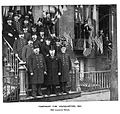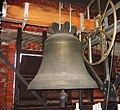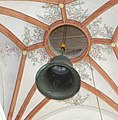User:Pigby2/Sandbox
Notre-Dame de Paris and Saint-Étienne de Paris were two Catholic basilicas collocated on the eastern end of the Île de la Cité in Paris, France in the Early to High Middle Ages which both alternately served as the cathedral of the diocese of Paris. The churches were demolished in the late 12th century during the construction of the current Notre-Dame de Paris which now sits over their foundations. In French, this earlier Notre-Dame is often called the primitive (“original”) Notre-Dame to distinguish it from the current cathedral of the same name. Nevertheless, this building of the 12th century was likely not the true original Notre-Dame, as archaeologists have discovered traces of at least four different churches built in this location before the current cathedral.
One of the churches stood in what is now the nave, crossing, and choir of Notre-Dame, possibly in-line with the current cathedral, while the other was just to the west in what is now the eastern end of the Parvis Notre-Dame and the narthex and nave of the current cathedral. It is now generally presumed that this church to the east was Notre-Dame while the church to the west was Saint-Étienne, but there is no direct evidence to support this.
articles[edit]
Hubert (1964)[edit]
There were two churches at the end of the High Middle Ages [sic] this has to mean by 1163. Notre-Dame and Saint-Etienne. At first historians surprised that they were there at the same time. But per Hubert this was an example of a "double cathedral" which were common throughout France and Northern Italy. 40 examples in France, although many date to the seventh century.
Saint Stephen was the "main" church. One of the churches was for the uninitiated (catechumens) and the other was for baptized believers.
Frist dig in March 16, 1711, made in the second bay of the choir, six feet below the pavement two parallel walls running north to south were discoered, built as if to support each other. The western wall was thinner and was believed to be older, This wall was partly made up of the bricks from the Pillar of the Boatmen. The eastern wall was thicker and believed to be older. Both walls in this area were removed to make way for the archbishops burial vault which was nine feet deep. It was 6 meters by 7 meters wide and long, 3 meters deep.
Hubert, Jean (1964). "Les origines de Notre-Dame de Paris" [The Origins of Notre-Dame de Paris]. Revue d'histoire de l'Église de France (in French). 147: 5–26. Retrieved 2021-07-27.
==US Flags--
-
15-star
-
37-star?
-
43-star
-
43-star?
-
45-star
-
45-star
-
45-star
-
45-star
-
45-star?
-
46-star?
-
45-star
-
48-star
-
48-star
-
48-star
Bells[edit]
-
Lever
-
Lever and chiming hammer
-
rope on windlass
-
Falling clapper
-
motor
-
partial windlass
-
Moveable type
-
rope to clapper
-
large windlass
-
double windlass
-
counter weight
-
lower lever
-
Munich
-
several
-
Weighted clapper
-
two
-
Audio
-
two
-
clappers
-
crown
-
crown
-
flying clapper
-
frame
-
frame
-
flying clapper
-
half windlass
-
windlass sizes
-
cranked swinging axis
-
oculus
-
pedal?
-
frame
-
flying clapper
-
pedal
-
pedals
-
Prague
Images[edit]
-
The western facade in 1840, five years before the start of the restoration
-
1850s during work on the portal of the Last Judgement
-
The western facade in the 1850s. The photo has been manipulated to show the gallery of kings fully restored. In reality, only six statues in the middle had been replaced by this time.
-
Later
-
Liberte Egalite Fraternite
-
1875
-
Date this
Sculptures of Notre-Dame de Paris[edit]
This is a list of sculptures in Notre-Dame de Paris.
Stone, copper, and bronze statues, including statues of the twelve Apostles that surrounded the base of the spire, had been removed from the site days prior to the 2019 fire as part of the renovations.[1][2]
Gallery of kings[edit]
The gallery of kings is a colonnade running the length of the western façade just above the three portals. The gallery includes 28 bays for 28 statues of kings, each about four meters high. The original statues date to the early 13th century. These were thrown down during the French Revolution, but some fragments have been recovered and are now displayed at the Musée de Cluny. The current statues date to the 1850s. The columns and the carvings of the arcade appear to be original.
No primary sources remain to indicate the originally intended identities of the 28 kings. According to 17th century French historian Henri Sauval, the statues represented the kings of France, starting with Childebert I and ending with Philip II. This belief evidently lasted until the Revolution as the statues became a target of anti-monarchical iconoclasm.
More recent scholarship has suggested the statues may have been meant to show the biblical kings of Judah or the genealogy of Jesus. According to the Gospel of Matthew, there are 28 generations from David to Jesus. If this was the intention, the last 13 figures were not actual kings, but pictured as such as carriers of the royal Davidic line from the time of the Babylonian captivity. The 14th king stands atop a lion, which may be a Lion of Babylon to symbolize the captivity, or the Lion of Judah to symbolize the last reigning king of Judah. Pre-Revolutionary sketches of Notre-Dame show this lion was part of the original design. (If this theory is correct, however, the 13th king corresponds to Josiah, not Jeconiah who is identified by Matthew as king during the captivity.)
It is not clear, however, that sculptors working under Lassus and Viollet-le-Duc intended any particular identities for the kings. The style of their regalia is decidedly medieval. The 14th king even holds a small cross, a symbol of Christianity.
13th century statues[edit]
-
five heads
-
five heads
19th century statues[edit]
-
1st king, 1st buttress
-
2nd king
-
3rd king
-
4th king
-
5th king
-
6th king
-
7th king
-
8th king, resembling Eugène Viollet-le-Duc
-
9th king
-
10th king, 2nd buttress
-
11th king
-
12th king
-
13th king
-
14th king, standing on lion
-
15th king
-
16th king
-
17th king
-
18th king
-
19th king
-
20th king, 3rd buttress
-
21st king
-
22nd king
-
23rd king, resembling Jean-Baptiste Lassus
-
24th king
-
25th king
-
26th king
-
27th king
-
28th king, 4th buttress
Chimeras[edit]
The gallery of chimeras is an upper walkway around and between the two bell towers. All of the chimera sculptures date to about the 1850s, being part of the the 19th century restoration.
South transept[edit]
| Image | Name |
|---|---|
 |
John the Baptist |
 |
Peter |
Sculptures in Notre-Dame de Paris[edit]
| Image | Name | Location | Artist | Date | Notes |
|---|---|---|---|---|---|
 |
Adam | West facade | |||
 |
Eve | West facade | |||
 |
Angel of the Resurrection | Roof | |||
 |
Denis of Paris | West facade | |||
 |
Saint Stephen | West facade | |||
 |
Gallery of Kings | West facade | |||
 |
Pietà | Interior | Nicolas Coustou | 1723 | |
 |
Louis XIII | Interior | Guillaume Coustou | Louis XIII consecrating his kingdom to the Virgin Mary. See The Vow of Louis XIII | |
 |
Jeanne d'Arc | Interior | Charles Desvergnes | See Joan of Arc | |
 |
Grand lutrin | Interior | Placide Poussielque-Rusand | 1868 | |
| Le Stryge | Roof | ||||
 |
Virgin of Paris | Interior | 14th century | ||
 |
Madonna and Child | West facade | |||
 |
Ecclesia | West facade | See Ecclesia and Synagoga | ||
 |
Synagoga | West facade | See Ecclesia and Synagoga | ||
 |
Unknown | Left of
Front Entrance |
|||
NDP template[edit]
References[edit]
- ^ "Notre-Dame Cathedral spire in Paris collapses, engulfed in flames". CBC News. Thomson Reuters. 15 April 2019. Archived from the original on 15 April 2019. Retrieved 15 April 2019.
- ^ Buncombe, Andrew (15 April 2019). "Notre Dame's historic statues safe after being removed just days before massive fire". The Independent. Archived from the original on 15 April 2019. Retrieved 15 April 2019.





































































































